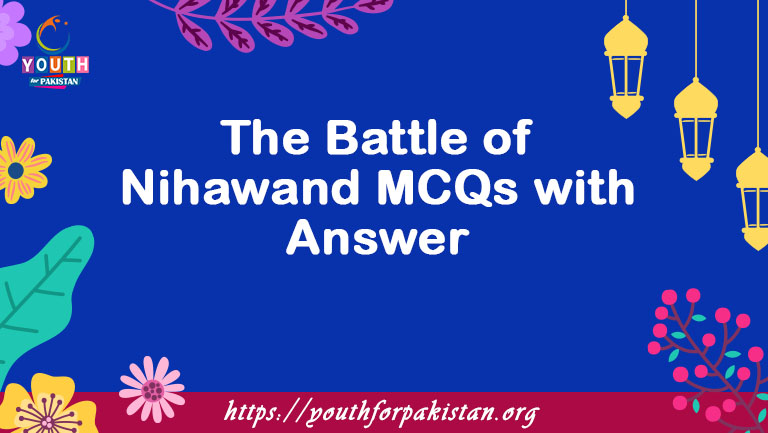The following are The Battle of Nihawand MCQs with answers related to Islamic Studies. We have arranged the most important and repeated MCQs in all the competitive examinations. The students can clear their concepts for The Battle of Nihawand MCQs online quiz by attempting these.
The Battle of Nihawand Online MCQs with Answers
Who were the primary opposing forces in the Battle of Nihawand?
a) Arab Caliphate and Persian Sassanid Empire
b) Mongol Empire and Byzantine Empire
c) Ottoman Empire and Mamluk Sultanate
d) Abbasid Caliphate and Umayyad Caliphate
In which century did the Battle of Nihawand take place?
a) 6th century
b) 7th century
c) 8th century
d) 9th century
Who led the Arab forces during the Battle of Nihawand?
a) Khalid ibn al-Walid
b) Ali ibn Abi Talib
c) Sa’id ibn Jubair
d) Al-Mufaddal ibn Umar al-Ju’fi
What was the main cause of the Battle of Nihawand?
a) Religious disputes
b) Territorial expansion
c) Control over trade routes
d) Dynastic succession
The Battle of Nihawand was a significant conflict in the early history of which Islamic empire?
a) Rashidun Caliphate
b) Umayyad Caliphate
c) Abbasid Caliphate
d) Fatimid Caliphate
Who emerged victorious in the Battle of Nihawand?
a) Arab Caliphate
b) Persian Sassanid Empire
c) It ended in a draw
d) Byzantine Empire
Which caliph was in power during the Battle of Nihawand?
a) Caliph Umar
b) Caliph Ali
c) Caliph Al-Mansur
d) Caliph Harun al-Rashid
What was the significance of the Battle of Nihawand in terms of territorial control?
a) It resulted in the conquest of Persia by the Arab forces
b) It led to the division of Arabia into multiple factions
c) It marked the end of the Arab expansion
d) It had no significant impact on territorial control
Which Persian city was near the site of the Battle of Nihawand?
a) Isfahan
b) Persepolis
c) Shiraz
d) Hamadan
What impact did the Battle of Nihawand have on the Persian Sassanid Empire?
a) It strengthened the empire’s hold on its territories
b) It marked the decline and eventual fall of the Sassanid Empire
c) It had no significant impact on the Sassanid Empire
d) It led to a period of peace and stability in the empire
Which river was located near the battlefield of Nihawand?
a) Tigris River
b) Euphrates River
c) Karun River
d) Nile River
The Battle of Nihawand is often associated with the early expansion of which religion?
a) Christianity
b) Zoroastrianism
c) Islam
d) Buddhism
What role did geography play in the outcome of the Battle of Nihawand?
a) The battle took place in a desert, favoring the Arab forces.
b) Mountains and terrain favored the Sassanid Empire.
c) The battle was fought on a coastal plain.
d) Geography had no significant impact on the outcome.
Which of the following was a key military leader on the Persian Sassanid side during the Battle of Nihawand?
a) Rostam Farrokhzad
b) Khalid ibn al-Walid
c) Abu Bakr al-Siddiq
d) Tariq ibn Ziyad
What impact did the Battle of Nihawand have on the Arab Caliphate?
a) It weakened the Arab Caliphate’s control over its territories.
b) It solidified the Arab Caliphate’s power in the region.
c) It led to the division of the Arab Caliphate into rival factions.
d) It had no significant impact on the Arab Caliphate.
Which dynasty succeeded the Umayyad Caliphate following the Battle of Nihawand?
a) Abbasid Caliphate
b) Rashidun Caliphate
c) Fatimid Caliphate
d) Ottoman Caliphate
What role did religion play in the motivations of the opposing forces in the Battle of Nihawand?
a) Both sides were motivated solely by religious factors.
b) Religion played no role in the motivations of the opposing forces.
c) Religion was a minor factor compared to other motivations.
d) Religion was a major factor but not the sole motivation.
Which famous Islamic scholar and historian chronicled the events of the Battle of Nihawand?
a) Ibn Khaldun
b) Ibn Taymiyyah
c) Ibn Ishaq
d) Ibn Kathir
The Battle of Nihawand is sometimes referred to as:
a) The Battle of Chains
b) The Battle of Roses
c) The Battle of Dunes
d) The Battle of Eagles
What impact did the Battle of Nihawand have on the Zoroastrian religion in Persia?
a) It led to the spread of Zoroastrianism in the Arab world.
b) It resulted in the decline of Zoroastrianism in Persia.
c) It had no impact on the Zoroastrian religion.
d) It led to the conversion of Arabs to Zoroastrianism.
What strategy did the Arab forces employ in the Battle of Nihawand that contributed to their victory?
a) Guerilla warfare
b) Siege tactics
c) Cavalry charges
d) Diplomacy
Which city served as the capital of the Persian Sassanid Empire at the time of the Battle of Nihawand?
a) Ctesiphon
b) Babylon
c) Persepolis
d) Shiraz
The Battle of Nihawand took place during the reign of which Sassanid monarch?
a) Khosrow I
b) Yazdegerd III
c) Shapur II
d) Ardashir I
What impact did the Battle of Nihawand have on the Arab-Persian cultural exchange?
a) It led to a flourishing of cultural exchange.
b) It resulted in the isolation of the Arab and Persian cultures.
c) It had no significant impact on cultural exchange.
d) It led to the assimilation of Persian culture into Arab culture.
Which of the following factors contributed to the decline of the Persian Sassanid Empire prior to the Battle of Nihawand?
a) Economic prosperity
b) Religious tolerance
c) External invasions
d) Strong centralized government
What was the role of Rostam Farrokhzad in the Battle of Nihawand?
a) He was the Arab commander.
b) He was a Persian general.
c) He mediated peace between the two sides.
d) He had no involvement in the battle.
What was the primary language spoken by the Arab forces during the Battle of Nihawand?
a) Arabic
b) Persian
c) Greek
d) Latin
How did the Battle of Nihawand impact the historical trajectory of the Arab world?
a) It marked the beginning of Arab decline.
b) It had no impact on the Arab world.
c) It contributed to the spread of Islamic civilization.
d) It led to the division of the Arab world into rival factions.
Which caliph succeeded Al-Mansur after the Battle of Nihawand?
a) Caliph Al-Wathiq
b) Caliph Al-Mahdi
c) Caliph Al-Hadi
d) Caliph Al-Rashid
What is the modern-day location of the Battle of Nihawand?
a) Iran
b) Iraq
c) Saudi Arabia
d) Syria
How long did the Battle of Nihawand last?
a) One day
b) One week
c) One month
d) One year
Which of the following contributed to the decline of the Persian Sassanid Empire before the Battle of Nihawand?
a) Economic prosperity
b) Strong centralized government
c) Religious unity
d) External conflicts
What was the main reason for the Arab victory in the Battle of Nihawand?
a) Superior military tactics
b) Larger army size
c) Religious fervor
d) Persian betrayal
Which major city did the Arab forces capture after their victory at Nihawand?
a) Isfahan
b) Baghdad
c) Damascus
d) Medina
Who was the commander of the Arab forces in the Battle of Nihawand?
a) Al-Mansur
b) Al-Hajjaj ibn Yusuf
c) Al-Mufaddal ibn Umar al-Ju’fi
d) Al-Abbas ibn al-Walid
How did the Battle of Nihawand affect the balance of power in the region?
a) It shifted power from Persia to the Byzantine Empire.
b) It resulted in a power vacuum in the region.
c) It solidified Arab control over Persia.
d) It had no impact on the balance of power.
What role did the Tahirid dynasty play in the aftermath of the Battle of Nihawand?
a) They led a Persian resurgence against the Arabs.
b) They established a new Arab dynasty in Persia.
c) They ruled as governors under the Abbasid Caliphate.
d) They were defeated and exiled from Persia.
Which Islamic dynasty claimed to be the rightful rulers of the entire Islamic world following the Battle of Nihawand?
a) Umayyad Caliphate
b) Rashidun Caliphate
c) Abbasid Caliphate
d) Fatimid Caliphate
What was the political significance of the Battle of Nihawand in the context of the Arab Caliphate?
a) It marked the beginning of the Umayyad Caliphate.
b) It solidified the Abbasid Caliphate’s authority.
c) It led to the fragmentation of the Arab Caliphate.
d) It had no political significance.
Which caliph of the Abbasid Caliphate was responsible for the victory at the Battle of Nihawand?
a) Al-Mansur
b) Al-Mahdi
c) Al-Hadi
d) Al-Rashid
What was the aftermath of the Battle of Nihawand for the Persian people?
a) Mass migration to Arabia
b) Continued resistance against Arab rule
c) Integration into Arab society
d) Conversion to Zoroastrianism
What role did the Karun River play in the Battle of Nihawand?
a) It served as a natural barrier protecting the Sassanid Empire.
b) It was a source of drinking water for both armies.
c) It facilitated the movement of troops during the battle.
d) It had no significant role in the battle.
Which famous Islamic scholar and historian wrote extensively about the events leading up to the Battle of Nihawand?
a) Al-Tabari
b) Ibn Khaldun
c) Al-Ghazali
d) Ibn Taymiyyah
What was the primary religion of the Persian Sassanid Empire during the time of the Battle of Nihawand?
a) Islam
b) Zoroastrianism
c) Christianity
d) Buddhism
Who served as the commander of the Persian Sassanid forces during the Battle of Nihawand?
a) Al-Mansur
b) Rostam Farrokhzad
c) Al-Mufaddal ibn Umar al-Ju’fi
d) Al-Hajjaj ibn Yusuf
What was the primary source of conflict between the Arab and Persian forces in the Battle of Nihawand?
a) Religious differences
b) Territorial disputes
c) Economic rivalry
d) Dynastic succession
Which Islamic dynasty succeeded the Umayyad Caliphate and played a significant role in the aftermath of the Battle of Nihawand?
a) Abbasid Caliphate
b) Rashidun Caliphate
c) Fatimid Caliphate
d) Umayyad Caliphate
What was the role of the Arab general Abu Muslim al-Khurasani in the events leading up to the Battle of Nihawand?
a) He led the Persian forces against the Arab Caliphate.
b) He played a key role in the Abbasid Revolution.
c) He was a prominent diplomat during the conflict.
d) He had no involvement in the battle.
How did the Battle of Nihawand contribute to the spread of Islam in the region?
a) It resulted in mass conversions to Christianity.
b) It led to the spread of Buddhism.
c) It facilitated the spread of Islam through conquest.
d) It had no impact on the spread of Islam.
What impact did the Battle of Nihawand have on the political structure of the Persian Sassanid Empire?
a) It reinforced the centralized government.
b) It led to the establishment of a republic.
c) It resulted in the fragmentation of the empire.
d) It had no impact on the political structure.










